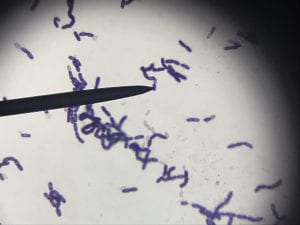I only got sequencing results for one of my three producers, so the identity of the other two will have to remain a mystery. The one that did work yielded about 725 base pairs of reliable sequence which matched 100% to the 16S ribosomal sequence for the Streptomyces genus. This genus is made of gram positive species and my gram stain results do agree: my gram stain yielded a purple cluster of rod-shaped bacteria set up in chains (see below; image taken from the “Meet my microbes” post – please see that post for further explanation).
As far as taxonomy goes, the organism belongs to the Bacteria kingdom, Actinobacteria phylum, Actinobacteria class, Actinomycetales order, and Streptomycetaceae family (3). Streptomycesis typically live in soil, decaying plant material, and/or water (3,4). They are also known for their quite wonderful smell, which has been called “earthy” and definitely contributed to the smell of the lab that we all became so fond of (3). This genus is known for forming branching chains, as was seen during the gram stain process (4). About 80% of antibiotics used today come from species in the Streptomyces genus, including chloramphenicol, daptomycin, neomycin, streptomycin, and so many more, so production of an antibiotic from my organism is more than plausible, suggesting the experimental method used here was sufficient for our purposes (2,3). Some species also produce antifungals and antiparasitic compounds (3). One study that was done to evaluate the specific nutrient requirements to produce optimal antibiotic production from one species found that they rely on copper, magnesium, zinc, and tryptophan heavily, but excel when provided sodium nitrate, potassium phosphate, and magnesium sulfate (3).
Sources:



Do oyu have a photo of the Gram stain? That would be nice to add:)